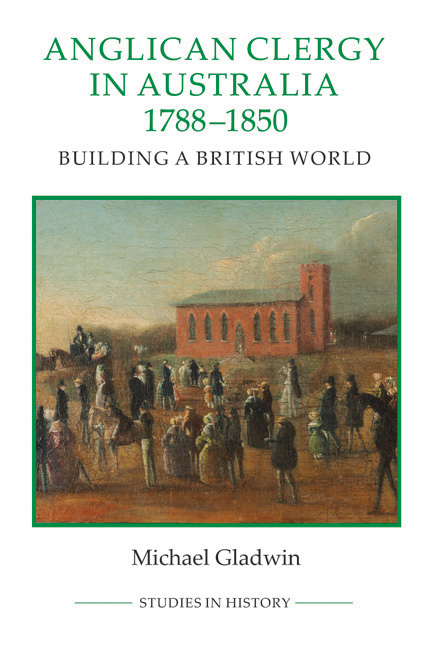Book contents
- Frontmatter
- Dedication
- Contents
- List of illustrations
- Acknowledgements
- Abbreviations
- Map
- Introduction
- PART I SINEWS: FUNDING, RECRUITMENT, BACKGROUNDS AND MOTIVATION, 1788-1850
- PART II CLERGYMEN IN COLONIAL AUSTRALIA, 1788-1850
- PART III SCENES OF COLONIAL CLERICAL LIFE: AUSTRALIAN CLERGYMEN AND VOLUNTARISM, 1836-50
- Conclusion
- Bibliography
- Index
Conclusion
Published online by Cambridge University Press: 05 December 2015
- Frontmatter
- Dedication
- Contents
- List of illustrations
- Acknowledgements
- Abbreviations
- Map
- Introduction
- PART I SINEWS: FUNDING, RECRUITMENT, BACKGROUNDS AND MOTIVATION, 1788-1850
- PART II CLERGYMEN IN COLONIAL AUSTRALIA, 1788-1850
- PART III SCENES OF COLONIAL CLERICAL LIFE: AUSTRALIAN CLERGYMEN AND VOLUNTARISM, 1836-50
- Conclusion
- Bibliography
- Index
Summary
In March 1816 the governor of NSW, Lachlan Macquarie, pronounced a court-martial (illegally as it turned out) on the Revd Benjamin Vale and had him marched unceremoniously through Sydney's dusty streets before rebuking him sternly in a private meeting. Vale had been in the colony only two years. In 1814, fresh out of Christ's College, Cambridge, and newly married, the scholarly twenty-six-year-old had arrived in Sydney as assistant chaplain to the 46th Regiment. Avowing patriotic impulse, Vale had helped William Moore, a colonial solicitor, seize an American cargo schooner in February 1816 as a prize of war, despite Macquarie having approved its entry. In the aftermath of the court-martial, Vale, Moore and Marsden protested to Bathurst against Macquarie's autocratic intemperance, cognisant that colonial Australian clergy held civil rather than military commissions. The affair had far-reaching implications: Bathurst's subsequent rebuke to Macquarie led to Macquarie's resignation in December 1817, but it also affirmed the Church's separation from its chaplaincy status as an institution in its own right. Vale and Moore's petition was also seized upon in parliament by the progressive Henry Grey Bennet as a means of urging reform of tory colonial policy. One result was the Bigge Commission and an ensuing volte-face in imperial policy on Australia.
Vale's experience, like that of Browne and Rogers with which this book began, is suggestive for the two questions at the heart of this study: first, how Anglican clergymen pursued their clerical vocation in the unique circumstances of colonial Australia and its wider imperial context; and second, the extent to which Anglican clergymen were agents of the colonial and imperial state. Although Vale escaped court-martial by virtue of his civil commission, like his Australian colleagues he was forced to reconcile the relatively unusual role of state-employed clergyman with that of Christian minister.
- Type
- Chapter
- Information
- Anglican Clergy in Australia, 1788–1850Building a British World, pp. 216 - 228Publisher: Boydell & BrewerPrint publication year: 2015

